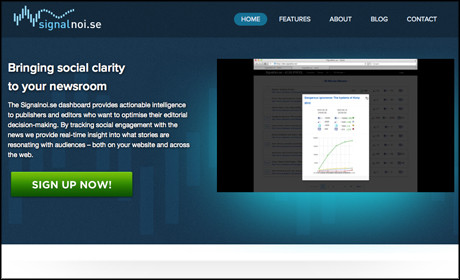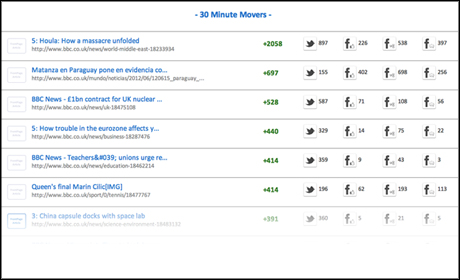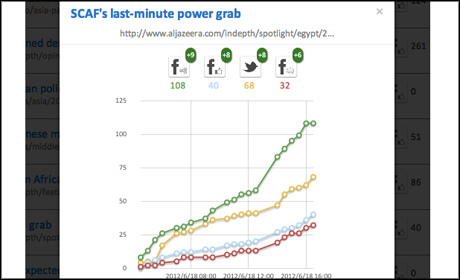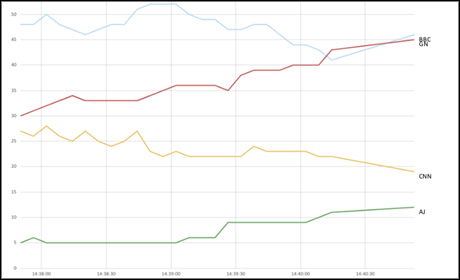
A new tool that will enable editors and journalists to track the activity of its own articles and those of its competitors on social networks was launched by the former head of online for Al Jazeera English yesterday.
SignalNoi.se was officially launched at the MIT-Knight Civic Media Conference on Monday (18 June) where it was also named one of the winners of the Knight News Challenge, one of two winning projects to receive undisclosed funding from the Knight Enterprise Fund "as a means for investing in commercial start-up ventures".
The tool was co-founded by Mohamed Nanabhay, who left his role as head of online for Al Jazeera English a month ago and has spent the past few weeks working on building the tool with co-founder Haroon Meer.
The platform provides editors with real-time social analytics for individual articles, "calculating constantly the social activity and the velocity each of those articles has", and highlights what stories are "resonating with audiences" to help editors make socially-informed editorial decisions.
Information provided on the dashboard includes how many tweets, Facebook likes, Facebook shares and Facebook comments a story has received, but the platform also offers an overall figure that is a "calculation we do that's tracking the velocity of the article".
"It's not just about the story with the biggest number of likes or tweets, because we don't think that gives you an accurate view of what's going on," Nanabhay told Journalism.co.uk. "You really want to look at how that story's performing over time."

This part of the dashboard, which can be applied to activity in the last 30 minutes, hour, week or month, will also highlight to the editor or journalist using it which articles are currently on the front page of the website.
"This is really interesting for editors because there might be stories that might have been written previously, maybe earlier that day, maybe a week ago, that are suddenly taking off on various social networks."
This then allows editors to make decisions based on the social activity.
The tool also enables users to "drill" further into individual stories and view a graph visualising how social activity has changed over time.

When editors see a spike in this graph it can prompt them to ask how to capitalise on that, he added, such as by writing a background piece, creating a profile or some other form of content. Or the graph may indicate that a story has "tapered out" and attention can be focused elsewhere.
And this can be especially useful when working with archived content, he added.
"Most people don't realise what's going on in their archives, especially with things like profiles, and sometimes profiles a year old, two years old, they've not been updated, but suddenly that person comes back into the news and now you've got an old profile but it's picking up a lot of interest and getting read. This tool gives you early alert to that.
"It's really aimed at looking at ways to help editors, help journalists, really figure out what's going on with the audiences, with the content and close that gap."
Competitor activity
And one of the key opportunities with the platform is the ability to see how the competition's content is performing.
Nanabhay said this can "take some of the pain away" for editors trying to keep up to date with the latest content being shared by other news outlets.
"You now have a tool, a dashboard, that allows you to monitor what's going on on those sites, and not just what they're publishing but what's taking off ... what the audiences are interested in."

As a result editors can find out what is "resonating with audiences" at large.
Another use of this feature is to know when a story that a news outlet may have already covered, is getting the most social traction.
"This gives you the heads-up to say this thing is taking off now, so what you need to do is start re-positioning that story, bringing it back up on your website, start pushing it out on your social media channels, because we've seen a lot of activity going on and that way you can try to recapture the audience."
Making better use of resources
Nanabhay also hopes the tool will help editors make better decisions in terms of where to focus what may be limited resources.
"Newsrooms are strapped for resources, editors are going to know what their editorial priorities are and they can then ask: 'what do we invest further time in and where do we point our journalists? Where do we spend that extra time?'
"So it's not supposed to feed this race to the bottom but rather meant to be a tool that allows editors to really ration the resources and produce extra content that's going to be read by audiences."
He added that he hopes the tool will help editors bring together what the news outlet wants to cover as part of its editorial and what the online audience is showing demand for.
"You've got the front page that we've chosen as editors, and [SignalNoi.se] is a front page chosen by your audience. What you really want to do is put those next to each other and say 'well what's the gap?'
"We've got our editorial prerogative, which is exactly what editors should be doing, but there's a gap as well and how do we bridge that and how do we connect those two."
He added: "The tool's not there to replace editors, it's not there for us to automatically start assigning what news stories go first, second and third. It's a tool that's in the editor's arsenal that they use to be able to make those decisions.
"We think the more data they have, the better data they have, the better those decisions are going to be."
The tool, which also provides data on articles across news outlets based on specific topics will be made available to interested news outlets via a subscription model offering a tiered service.
The company is currently working with a group of "select publishers" which have been testing the platform in private beta. And now the company has officially launched Nanabhay said there has already been "a huge amount of interest".
Free daily newsletter
If you like our news and feature articles, you can sign up to receive our free daily (Mon-Fri) email newsletter (mobile friendly).
Related articles
- Tool for journalists: Story SpinnerAI, for generating story angles based on user needs
- Six self-care tips for journalists to stay sane during the general election
- RISJ Digital News Report 2024: Three essential points for your newsroom
- Why TikTok star Sophia Smith Galer created an AI tool to help journalists make viral videos
- Seven tips for using LinkedIn as a freelance journalist









